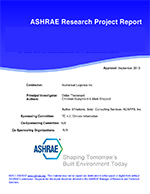Description
Ventilation characteristics and bioaerosol concentrations were evaluated in four poultry slaughter plants. Supply and exhaust airflow rates for each room were measured along with internal air distribution. Each plant used a negative pressure ventilation system without make-up air systems. The primary exhaust capacity was achieved with large roof-mounted exhaust fans in the defeathering rooms. Total airflow of these fans ranged from 25,400 to 98,800 cmh (14,941 to 58,118 cfm). Airflow in the plants typically moved from areas of low bioaerosol concentrations to areas of high bioaerosol concentrations. Because of the lack of planned intakes, air infiltrated into the building through shackle line openings, shipping dock doors, and other openings in the building envelope. Room air distribution was unplanned and unmanaged.
The objectives of the investigations of four poultry slaughtering plants were to:
1. evaluate the ventilation of the plants for airflow capacity and air distribution,
2. characterize concentrations, size distribution, and sources of major bioaerosols, including total aerobic mesophilie bacteria, psychrotrophic bacteria, and yeasts and molds.
3. identify predominant yeast and molds to the genus level.
4. characterize concentration and sources of minor bioaerosols, including Pseudomonas spp., Listeria monocytogenes, Staphylococcus aureas, spp, Escherichia coli, Salmonella, spp and Lactobacilli.
5. correlate bioaerosol concentrations with ventilation airflow and air distribution.
6. provide recommendations for plant layout and ventilation system design to minimize bioaerosol levels.
Product Details
- Published:
- 2001
- Number of Pages:
- 193
- File Size:
- 1 file , 4.7 MB
- Product Code(s):
- D-RP-834




